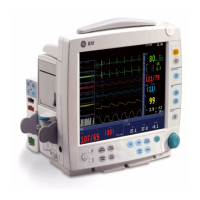System description
2-33
Temperature
1
Measurement range: 10 to 45 °C (50 to 113 °F)
Measurement accuracy: ±0.1 °C (25 to 45 °C)
Probe type: Use only GE Healthcare temperature probes or defibrillator-proof
YSI 400 series probes.
Temperature self-check: At start-up and then every 10 minutes.
Time constant of temperature probes:
Reusable skin temperature probe: 3 s
Reusable adult central temperature probe: 6 s
Reusable pediatric central temperature probe: 4 s
Disposable skin temperature probe: 3 to 6 s
Disposable central temperature probe, 12F: 5 to 8 s
Disposable central temperature probe, 9F: 5 to 8 s
NIBP
Measurement range: adult 25 to 260 mmHg (3.3 to 34.7 kPa)
child 25 to 190 mmHg (3.3 to 25.3 kPa)
infant 15 to 140 mmHg (2.0 to 18.7 kPa)
Typical measuring time: adult less than 30 s, infant less than 25 s
Overall system accuracy: Meets or exceeds SP10-2002 AAMI standards
2
The ESU does not cause a burn hazard through the NIBP cuff, because there is no electrical connection
between the cuff and the NIBP measuring electronics.
NOTE: NIBP measurement is intended for patients who weigh 5 kg (11 lb) and up.
NOTE: The cuff pressure measurement range is equal to cuff nominal and cuff
indication ranges.
Pulse oximetry
SpO
2
1
Automatic scaling of plethysmographic waveform.
Measurement and display range: 0 to 100 %
Calibration range: 70 to 100 %
Calibrated against functional oxygen saturation.
Measurement accuracy
3
: 100 to 70 %, ±2 digits
69 to 0 %, unspecified
Display resolution: 1 digit (1% of SpO
2
)
Wavelength of SpO
2
probe LEDs:
Infrared LED 940 nm
Red LED 660 nm
Maximum energy of SpO
2
probe LEDs:
Infrared LED 42 µJ/pulse
Red LED 62 µJ/pulse
Pulse rate:
Measurement and display range: 30 to 250 bpm
Measurement accuracy
4
: ±5 % or ±5 bpm, whichever is greater
1 The isolation barrier capacitance in the module has been minimized to reduce the hazard of burns in the event of a
defect in the ESU return electrode connection.
2 According to SP10-2002 AAMI 4.4.5.2.B, Intra-arterial method as the reference standard, mean difference of the test
system and the comparison system shall be ± 5 mmHg or less with standard deviation of 8 mmHg or less
3 Accuracy is based on deep hypoxia studies with volunteered subjects during motion and non-motion conditions over a
wide range of arterial blood oxygen saturations as compared to arterial blood CO-Oximetry. Accuracy may depend on
the sensor used, please refer to the instructions for use in the accessory package. The accuracy is expressed as rms. This
means that approximately two-thirds of the data will fall within the accuracy range.

